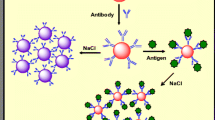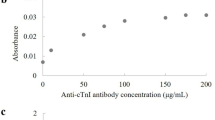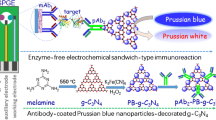Abstract
Digoxin is widely used as a cardiac glycoside drug in the treatment of various heart conditions. Because it is a toxic drug, it should be regularly monitored in the serum of patients under treatment. In this study, colloidal nanogold is synthesized and the preparation of nanogold-labeled monoclonal antibody probe to digoxin is described under optimal conditions. In addition, an immunochromatographic (IC) method for digoxin analysis employing nanogold-labeled probe is developed. With this technique, it requires only 5 min to complete the quantitative detection of digoxin. The detection time is decreased 20–30 times in comparison to radioimmunoassay (RIA). The sensitivity to digoxin was about 2 ng/ml by naked eye, which is within the therapeutic and toxic ranges of digoxin. The results of serum samples obtained by IC strip were in agreement with those obtained by RIA. The IC strip was sufficiently sensitive and accurate to be used for the rapid detection of digoxin in serum samples.







Similar content being viewed by others
References
Higashi, Y., Ikeda, Y., Yamamoto, R., et al. (2005). Life Sciences, 77, 1055–1067. doi:10.1016/j.lfs.2005.03.003.
Ahmed, A., Young, J. B., & Gheorghiade, M. (2007). Canadian Medical Association Journal, 176, 641–643. doi:10.1503/cmaj.061239.
Dasgupta, A., Kang, E., & Datta, P. (2006). Journal of Clinical Laboratory Analysis, 20, 204–208. doi:10.1002/jcla.20133.
Al-musallam, M. (2006). [dissertation]. Molecular Medicine, Cranfield University, Cranfield Health.
Graefe, K. A., Tang, Z., & Karnes, H. T. (2000). Journal of Chromatography. B, Biomedical Sciences and Applications, 45, 305–314. doi:10.1016/S0378-4347(00)00304-2.
Ikeda, Y., & Fujii, Y. (2005). Biological & Pharmaceutical Bulletin, 28, 340–343. doi:10.1248/bpb.28.340.
Dasgupta, A., Kang, E., Olsen, M., et al. (2007). Archives of Pathology & Laboratory Medicine, 131, 619–621.
Wu, Y. S., Lei, L. M., & Li, M. (2005). Di Yi Jun Yi Da Xue Xue Bao, 25, 761–765.
Paek, S. H., Lee, S. H., Cho, J. H., Kim, Y. S., et al. (2000). Methods (San Diego, CA), 22, 53–60. doi:10.1006/meth.2000.1036.
Xiulan, S., Xiaolian, Z., Jian, T., et al. (2005). International Journal of Food Microbiology, 99, 185–194. doi:10.1016/j.ijfoodmicro.2004.07.021.
Lee, E. Y., Kang, J. H., Kim, K. A., et al. (2006). Journal of Immunological Methods, 308, 116–123. doi:10.1016/j.jim.2005.10.010.
Molinelli, A., Grossalber, K., Führer, M., et al. (2008). Journal of Agricultural and Food Chemistry, 56, 2589–2594. doi:10.1021/jf800393j.
Pastoor, R., Hatta, M., Theresia, H., et al. (2008). Diagnostic Microbiology and Infectious Disease, 61, 129–134. doi:10.1016/j.diagmicrobio.2007.12.014.
Bienek, D. R., Biagini, R. E., Charlton, D. G., et al. (2008). Clinical and Vaccine Immunology; CVI, 15, 644–649. doi:10.1128/CVI.00473-07.
Beck, O., Kraft, M., Moeller, M. R., et al. (2000). Annals of Clinical Biochemistry, 37(Pt 2), 199–204. doi:10.1258/0004563001899005.
Chiao, D. J., Shyu, R. H., Hu, C. S., et al. (2004). Journal of Chromatography. B, Analytical Technologies in the Biomedical and Life Sciences, 809, 37–41. doi:10.1016/j.jchromb.2004.05.033.
Zhang, G., Wang, X., Zhi, A., et al. (2008). Food Additives and Contaminants, 25, 413–423. doi:10.1080/02652030701561452.
Zhang, G. P., Wang, X. N., & Yang, J. F. (2006). Journal of Immunological Methods, 312, 27–33. doi:10.1016/j.jim.2006.02.017.
Won-Bo, S., Yang, Z. Y., Kim, J. S., et al. (2007). Journal of Microbiology and Biotechnology, 17, 1629–1637.
Choi, M. J., Kim, S. Y., Choi, J., et al. (1999). Microchemical Journal, 63, 92–99. doi:10.1006/mchj.1999.1770.
Gui, W. J., Wang, S. T., Guo, Y. R., & Zhu, G. N. (2008). Analytical Biochemistry, 377, 202–208. doi:10.1016/j.ab.2008.03.013.
Hermanson, G. T., Mallia, A. K., & Smith, P. K. (1992). Immobilized affinity ligand techniques p. 54. San Diego: Academic.
Acknowledgment
This research has been supported by the Endocrinology Metabolism Research Center of Tehran University of Medical Sciences, Tehran, I.R. Iran.
Author information
Authors and Affiliations
Corresponding authors
Rights and permissions
About this article
Cite this article
Omidfar, K., Kia, S., Kashanian, S. et al. Colloidal Nanogold-Based Immunochromatographic Strip Test for the Detection of Digoxin Toxicity. Appl Biochem Biotechnol 160, 843–855 (2010). https://doi.org/10.1007/s12010-009-8535-x
Received:
Accepted:
Published:
Issue Date:
DOI: https://doi.org/10.1007/s12010-009-8535-x




